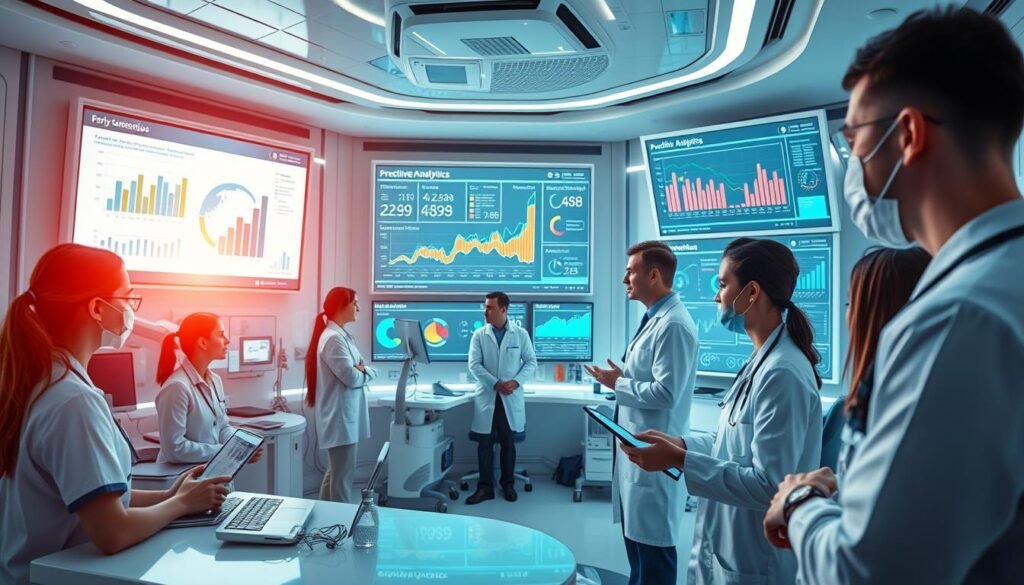Did you know that breast cancer deaths in Canada have dropped by about 48% since 1986? This big decrease is mainly because of better treatments and early detection, like mammograms. Risk assessment plays a key role in spotting health threats early. This can save lives.
Understanding the value of risk assessment for early detection is crucial in healthcare. It allows organizations to pinpoint and handle risk factors efficiently. It’s not just about numbers. It involves looking at each person’s health closely. Thanks to better data gathering and tech in healthcare, finding problems early is now more doable. This approach lowers disease rates and deaths. It also improves overall health outcomes. For those who want to learn more about assessing risks, check out this insight on risk assessment.
Also, knowing the link between chronic conditions like COPD and lung cancer risk is crucial. It’s important because signs of both can be hard to tell apart. This makes early and correct diagnosis key. For more on how these conditions are related, read about COPD and lung cancer symptoms.
Key Takeaways
- Risk assessment is vital in early detection and management of health conditions.
- Timely risk evaluations can significantly enhance patient outcomes and healthcare quality.
- Personalized risk assessments allow for targeted and effective disease prevention strategies.
- Advances in data analytics improve the accuracy and efficacy of risk management.
- Understanding the nuances of symptoms can aid in timely diagnosis and treatment.
- Employing a structured risk assessment framework helps organizations prioritize interventions effectively.
Understanding Risk Assessment
Risk assessment is key in spotting and judging health risks linked to diseases. It lets healthcare workers make plans that prevent diseases early. This improves health greatly.
Definition and Key Components
The risk assessment definition means a step-by-step method to find and assess health risks. Important components of risk assessment include:
- Health history
- Lifestyle choices
- Genetic predispositions
- Environmental exposures
These elements help in giving care that meets each person’s needs. This way, prevention can match what each person needs.
The Role of Data in Risk Assessment
Data is crucial in assessing risks well. It supports data-driven decision making. Health workers gather important info from health records and demographics. This helps them:
- Do thorough risk evaluations
- Spot particular risk factors in disease
- Make plans to improve health
It’s key for risk assessments to keep improving. Keeping them up to date helps adapt to new health issues and dangers. This keeps the focus on better care for patients.
Importance of Risk Assessment for Early Detection
Risk assessment is key in finding health issues early. It helps improve health by catching problems before they grow. This makes treatments work better and faster. So, doctors and nurses need to use good risk assessment methods often.
Impact on Health Outcomes
Doing risk assessment well leads to better health. It finds health risks early, so doctors can give the right care sooner. Research shows this prevents serious diseases from getting worse. It means people can enjoy a higher quality of life.
Reducing Disease Burden and Mortality
Risk assessment helps in more ways than one. It finds health risks early, cutting down on disease and deaths. Quick action can stop diseases from spreading. It saves money on health care and makes people’s lives better.
Also, stopping problems before they start keeps communities healthier. This shows why it’s so important to manage health risks well.
Factors Influencing Early Detection
Several factors affect how early we can find diseases. They include our biology and our environment. Understanding these can help us to assess risks better and improve health.
Biological and Environmental Exposures
Things like age, sex, and health conditions can make us more likely to get sick. For example, older people often get sicker than younger ones.
Our environment matters too. Air pollution, eating habits, and our way of life can raise our risk of disease.
Genetic Risk Screening
Checking our genes is a key way to see if we might get certain diseases. It helps us find people who need early care.
These screenings show us what can affect disease detection. They help doctors come up with plans to lower risk.
| Type of Exposure | Examples | Influence on Detection |
|---|---|---|
| Biological | Age, Sex, Health Conditions | Higher disease susceptibility in older individuals |
| Environmental | Pollutants, Diet, Lifestyle | Increased risk of various diseases |
| Genetic | Family History, Genetic Markers | Identifying predisposed individuals for timely intervention |
Understanding how biology, environment, and genetics mix plays a big role in finding diseases early. This knowledge helps target efforts to lessen the impact of diseases.
Proactive Health Monitoring
Proactive health monitoring is changing healthcare today. It aims at spotting health problems early through new tech and ongoing check-ups.
Technological Advances in Monitoring
Thanks to health tech improvements, people have advanced tools for keeping an eye on health. Wearables, like smartwatches and fitness trackers, let users check their health signs and activity. These gadgets are key in proactive health monitoring, helping spot health issues early.
Integrating Lifestyle Risk Factor Analysis
Adding lifestyle checks into risk reviews gives a clearer picture of how daily actions affect health. This helps doctors tailor plans better by looking at diet, workout, and stress levels. With health data, people can choose better health paths, cutting down chronic disease risks.

| Wearable Device | Features | Benefits |
|---|---|---|
| Apple Watch | Heart rate monitoring, ECG, activity tracking | Real-time health tracking and alerts for irregular heartbeats |
| Fitbit Charge 5 | Health metrics dashboard, stress management tools | Encourages lifestyle changes through insightful data |
| Garmin Forerunner | Advanced sleep tracking, VO2 max estimation | Optimizes training and recovery for better performance |
Risk Mitigation Strategies
Effective risk mitigation includes various steps to keep health safe and lower threats. It’s about knowing the approach that suits you or your group’s needs. This part discusses key actions to cut down health risks by being proactive and stepping in early.
Preventative Care Measures
Preventive care is vital in avoiding risks. It focuses on spotting and handling health problems early. Health checks and shots are crucial. By following health screening recommendations, you can catch health problems before they worsen. Making changes in your lifestyle, like eating right and staying active, also plays a big role.
Implementing Early Intervention Techniques
Using early intervention techniques helps in fighting health threats faster. For example, getting tests done early can find diseases sooner, making treatment more likely to work. These efforts need doctors to work together, which helps early intervention effectiveness. This teamwork is key to lowering disease and underscores why it’s important to manage risks.
| Risk Mitigation Strategy | Description | Example |
|---|---|---|
| Risk Reduction | Minimizing identified risks through specific measures. | Implementing health screenings. |
| Risk Transfer | Shifting the responsibility of risks to third-party entities. | Using cloud service providers for data security. |
| Risk Avoidance | Avoiding actions that could lead to risk exposure. | Choosing not to engage in risky health behaviors. |
| Risk Acceptance | Acknowledging risks when the costs of mitigation exceed the potential harm. | Managing risks associated with mild lifestyle choices. |
For more on managing risks effectively, read about risk mitigation strategies in business.
Predictive Analytics in Healthcare
Predictive analytics is changing healthcare. It lets groups understand big data sets well. This method looks at past trends to predict future ones. It helps make clinical choices and guidelines better. Using healthcare data goes far beyond just watching. It turns into real plans for caring for patients and using resources.
Data-Driven Risk Assessment Models
Data-driven models are key in predicting health risks using analytics. They help doctors figure out the chances of diseases for better treatment. With smart stats, they find patients at high risk. This leads to fast and right treatments for each person.
Here’s a breakdown of essential predictive modeling parts:
| Key Element | Description |
|---|---|
| Data Collection | Gathering extensive patient data from various sources for comprehensive analysis. |
| Feature Selection | Choosing relevant variables to enhance model performance and avoid overfitting. |
| Algorithm Choice | Selecting appropriate algorithms such as logistic regression or neural networks based on data characteristics. |
| Model Evaluation | Utilizing metrics like accuracy and F1 score to assess model effectiveness. |
| Compliance Considerations | Ensuring adherence to privacy regulations like HIPAA in handling sensitive data. |
Predictive analytics helps healthcare lower costs, like those from hospital returns. It makes patient care better too. Seeing health problems before they get bad means quick help, making patient health better. Data insights from this help manage long-term illnesses, stick to treatments, and improve how clinics work.

The Role of AI-Powered Diagnostic Tools
AI-powered diagnostic tools are changing healthcare, especially in spotting diseases early. They use the latest machine learning to improve how accurately and quickly doctors can diagnose different health issues.
Enhancing Accuracy in Early Detection
AI is making disease detection faster and more precise. For example, AI can examine medical images and data better than old methods. Convolutional Neural Networks (CNN) are especially good at spotting problems quickly, leading to quicker, more reliable diagnoses.
This technology is making a big difference in cancer care. It helps find breast cancer earlier through image analysis. Finding cancer early can greatly improve how well treatment works.
Real-World Applications and Benefits
The ways these diagnostic tools are used are many and meaningful:
- Clinical Decision Support Systems: AI helps doctors diagnose and plan treatments, cutting down on mistakes.
- Healthcare Analytics: By predicting how many patients will come in, hospitals can plan better, improving care and use of resources.
- Natural Language Processing: This AI takes unstructured notes and makes them useful, helping with decisions and research.
- Robotics in Surgery: Robots guided by AI make surgery more precise and help patients recover faster, changing how surgeries are done.
- Virtual Nursing Assistants: These AI systems handle records and answer routine questions, making healthcare processes smoother.
- Medication Management: AI sends reminders and warns about drug interactions, making medication use safer.
- Patient Monitoring: Wearable AI devices monitor health signs in real time, allowing for quick action and better health results.
- Personalized Treatment Plans: AI looks at lots of health data to make customized treatment plans, improving how well treatments work.
- Drug Discovery: AI speeds up finding new medicines, helping push medical research forward.
Ethical Considerations in Risk Assessment
Ethical considerations are key in risk assessment. They help balance effective health care with respecting patient autonomy and privacy. The importance of keeping health data private is growing clearer. Patients need to trust that their information is safe during assessments.
Fears of being judged based on risk information can arise. This may stop people from speaking openly. Transparent communication in health systems is critical to address these concerns.
Autonomy and Privacy Issues
Patient autonomy is vital in health care, especially in risk assessment ethics. It’s important to make sure people know how their data will be used. Talking to patients about their choices helps them take part in decisions. But, over-medicalization can cause unneeded interventions and stress for patients.
Tools like those Professor Hippisley-Cox created help manage risks better. Ethical risk management means finding a balance. It’s about improving patient health while sticking to ethical guidelines. Building trust in health systems is essential for fair health policies that respect patients and ethics.

Community Health and Public Awareness
Community health initiatives and public health education are key in making people aware of disease risks. They share information about health concerns and risks. This helps everyone know how their choices, surroundings, and genes might affect their health.
Educating the Population on Disease Risks
Public health campaigns aim to reach everyone with important, science-based facts. They talk about how to prevent diseases and where to find help. These efforts can change how people act, making them live healthier lives. For instance, many people tried a heart disease risk test on a health app, showing these campaigns work.
Building Trust in Health Systems
Trusting our health systems is very important for community involvement. If people believe in their healthcare and its quality, they’ll join health programs more. Creating a friendly place with clear info about health risks and benefits improves trust. Health workers need to connect with the community to boost this trust. Building such connections is vital for the success of health projects.
Conclusion
Risk assessment is key in spotting health issues early, greatly bettering the care people receive. It helps find health dangers and take steps to lessen them. With a detailed risk assessment method, healthcare workers can tackle tough problems. These include medication mistakes and concerns about keeping patients safe. This effort makes care places safer for everyone.
The value of catching health problems early is huge. Using Electronic Health Records and tools for assessing health risks, medical experts can tailor care. They can make patients more involved and lower disease rates. This shows how using data and health risk assessments work well. They help predict and stop big health problems.
The outlook for risk assessment in healthcare looks good. Better methods, more involvement from everyone, and adding different opinions will improve public health. By being proactive, caregivers and health systems aim to build a culture of wellness. They want to reduce risks and make health better for people and communities.